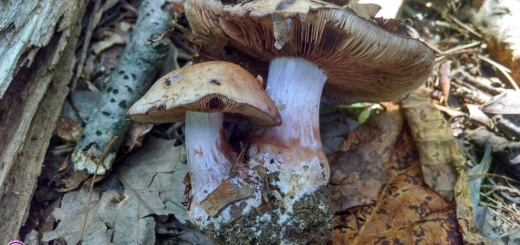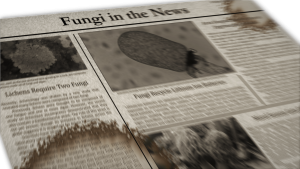#120: Geastrum saccatum
This mushroom is one of the most common earthstars and can be found all across the globe. Geastrum saccatum does not have an official common name, although the name “Rounded Earthstar” is occasionally used. Most of the time, it is just called “an earthstar.” Most North American earthstars look very similar to saccatum, but it is possible to tell them apart without running for a microscope.
G. saccatum starts out looking pretty much like just another puffball or earthball. Young mushrooms are brown, spherical, 2-3cm (about 1in) wide, and attached to the ground at a single point. The one feature that separates them from other gastroid fungi at this stage is the presence of a small, conical area roughly at the top of the mushroom.
Once the earthstar is ready to release its spores, cracks form at the tip of the conical area and the outer layer peels back to form between 4 and 9 (or sometimes more) “arms.” Each arm is light brown on top, roughly triangular, and curls underneath the mushroom’s base. The mushroom remains attached to the ground and the arms do not lift the mushroom up. Unlike the Barometer Earthstar (Astraeus hygrometricus), the arms of G. saccatum are not hygroscopic (they do not fold and unfold as they dry out and become wet). This mushroom is small for an earthstar, reaching a diameter of only 2-5cm (roughly 1-2in) with arms fully open.
A small, puffball-like structure rests in a shallow depression at the center of the arms. This part of the mushroom is roughly spherical, smooth, and brown to dark brown. The top of this sphere has a small conical section that sits in a slightly depressed ring. Usually, the ring is lighter in color than the cone and the sphere. If you cut open the spherical part in a young specimen, the interior will be white and solid. As the mushroom matures, the inside becomes brown and powdery. Like the interior, the spores are brown and powdery.
The spherical part of the earthstar contains the spores, which escape via a pore in the middle of the cone. Like puffballs, spore discharge occurs primarily when raindrops hit the top of the sphere. When a raindrop lands, it pushes down the earthstar’s surface and forces out a puff of spores. This helps the spores escape the stagnant layer of air near the surface of the ground and get into active air currents. From there, the spores are carried by the wind to new habitats.
G. saccatum is saprobic and can be found on the ground underneath both conifers and hardwoods. Although it decomposes plant debris and is often found around stumps, it does not grow directly on coarse woody debris (logs and the like). The mushroom is found in forests throughout the world and is widely distributed and common in North America. Look for this mushroom in the summer through the fall. In warmer climates, the G. saccatum may also fruit in the winter.
There are a number of North American earthstars that look very similar to G. saccatum. G. triplex differs because the material which forms the upper layer of its arms always cracks, forming a bowl-like structure at the base of the spore case. G. fimbricatum can be distinguished by its lack of a ring-like depression at the base of the conical pore. It is also attached to its substrate all over the surface before it opens, so the young mushrooms and undersides of the arms of mature mushrooms are usually covered with dirt and other debris. Other earthstars are larger, have decorations on their conical pore section, and/or have spore cases that are raised above the surface of the arms by a short stalk.
G. saccatum is inedible, at least when mature. To even consider eating it, you have to get very young fruiting bodies without open arms and that have not begun to produce spores. I don’t know of anyone who routinely eats G. saccatum. However, one study from Brazil found that the earthstar contained a lot of beta-glucan, which has antioxidant, anti-inflammatory, and cytotoxic properties. Presumably, this study was prompted by people either using the mushroom medicinally or having a desire to use the mushroom medicinally. I do not recommend eating this mushroom because it is small and is apparently not culinarily interesting. Additionally, many mushrooms listed as “inedible” may contain some toxins that are not reported because nobody eats the mushroom on a regular basis.
See Further:
http://www.mushroomexpert.com/geastrum_saccatum.html
http://www.mykoweb.com/CAF/species/Geastrum_saccatum.html








![#011: Characteristics of Kingdom Fungi [Archived]](https://www.fungusfactfriday.com/wp-content/themes/hueman/assets/front/img/thumb-small-empty.png)


1 Response
[…] are a number of variations on this basic morphology. Earthstars like Geastrum triplex and Geastrum saccatum have four to ten points and the gleba remains nestled in a small bowl at the center of the star. […]